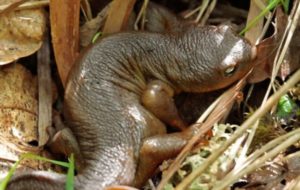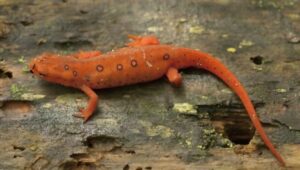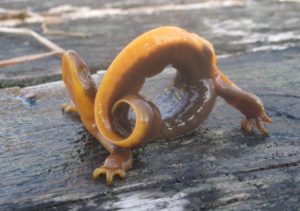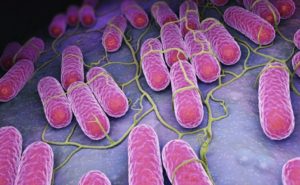Newts are endearing little creatures that are fun to observe in the wild and make amusing pets. While they seem defenseless when it comes to fending off hungry predators, they have a few tricks to keep predators away. But are newts poisonous?
All newts produce poisonous secretions that make them distasteful or lethal to most predators. The toxins produced by some species are more poisonous than those produced by others. However, these toxins are only harmful when ingested, so you are unlikely to be harmed, provided you do not eat or lick a newt.
Since most people won’t try to eat a newt, you are most likely to come in harm’s way by handling a newt with your bare hands, then rubbing your eyes, or touching your mouth without first washing your hands.
Doing this would enable the toxin to come in contact with your mucus membranes, most likely leading to irritation and/or a painful sting.
As a safety precaution, wash your hands after handling any newts. Before washing your hands, do not touch anything, but especially not your eyes or mouth.
Most Newts Are Only Mildly Poisonous
Fortunately, you are unlikely to be harmed by these toxins by simply touching a newt. The toxins are only harmful when they are ingested. Even newts with potent toxins are generally safe and unlikely to ever cause serious harm unless the newt was licked, placed in the mouth, or swallowed.
Why Newts Developed a Toxic Defense
Newts are small, slow-moving creatures with soft bodies, making them ideal prey for many birds, fish, and even larger amphibians. This means they need a way to ward off all these animals that could eat them.

As the first line of defense, most newts have a coloration that helps them camouflage or blend into the leaves and other debris in their environments, escaping the notice of most predators.
However, camouflage alone is not enough, so most newts produce toxic secretions as an added layer of defense.
When threatened, they will secrete these toxins all over their skin which makes them distasteful or lethal to most predators. Some newts may also position themselves in a way that places their main poison glands closest to the attacker.
Some Newts Advertise Their Toxicity by Displaying Bright Colors
Many newts tell potential predators they are poisonous by displaying bright or contrasting colors. This is called aposematism or warning coloration.

Newts, such as the red-eft stage of the eastern newt have a brilliant coloration that runs all over their body, but others, such as the rough-skinned newt only have the bright coloration on their abdomen.
When approached by a predator on land, these newts will arch their back, to show off their brightly colored underside to warn potential predators not to eat them. Think of it like holding up a sign that says “don’t eat me I’m toxic!”

A predator that eats a newt with such coloration may get very sick and remember the experience. The next time that predator sees another similarly colored newt, it will associate the colors with danger and learn to avoid that species. In this way, the coloration acts as a defense.
Most Newts Are Poisonous but Do Not Have Any Venom
People often use the words “poisonous” and “venomous” almost interchangeably, but there is a difference between the two.
Generally;
- Venomous animals are those that inject their toxins, usually through fangs or stings, into their victims (think, rattlesnakes). Poisonous animals, on the other hand, are toxic if you eat them or ingest their toxins (think poison dart frogs).
- Venomous animals usually use their toxin to hunt, while poisonous animals use their toxin to stop other animals from eating them.

Most Newts are harmful when their secretions are ingested but do not have any ability to actively inject this toxin, so they are considered poisonous but not venomous.
Some Newts Are Venomous
While most newts only passively deliver their toxins, others, such as the Spanish ribbed newt (and several crocodile newts) can actively inject their toxin using sharp ribs that protrude through their skin. This means they are technically venomous.

When grasped by a predator, these newts will push their sharp ribs through tubercles running down the sides of their body. As the ribs pierce the skin, the newt secretes a milky toxin from special glands on its body.
The toxin-covered ribs then “sting” the predator injecting the toxin in the process. This process does not harm the newts and the pierced skin quickly heals without any problems.
Since these newts actively inject their toxins (remember the difference between poisonous and venomous) they can be considered venomous.
Newts Typically Aren’t Dangerous to Humans
Although poisonous, newts are generally not a danger to humans provided that they are handled carefully and gently. Even the venomous newts can be harmless when handled carefully.
The only harm comes when their toxins are ingested, usually through contact with mucous membranes (such as eyes, nose, or mouth) or breaks in the skin.
This can happen when you pick up a newt with your bare hands, then rub your eyes or put something in your mouth without first washing your hands. In most cases, this will just lead to irritation but will not cause serious harm.
However, eating, licking, or placing a newt in your mouth can be fatal. While this may seem obvious, it has happened. There is at least one recorded case of a man swallowing a rough-skinned newt on a bet; he died shortly afterward.
What Newts Are the Most Poisonous?
The rough-skin newt produces the most potent (most poisonous) toxin of any newt. This newt secretes a toxin consisting mainly of a highly poisonous neurotoxin known as tetrodotoxin, which makes it one of the most toxic animals known to science.
Below, is a chart of 16 different newts and their degree of toxicity
| Type of Newt | Degree of Toxicity |
| Rough-skinned Newt | Extremely Poisonous |
| Red-bellied Newt | Extremely Poisonous |
| Sierra Newt | Extremely Poisonous |
| California Newt | Extremely Poisonous |
| Emperor Newt | Extremely Poisonous |
| Japanese Firebelly Newt | Highly Poisonous |
| Hong Kong Warty Newt | Highly Poisonous |
| Chinese Warty Newt | Highly Poisonous |
| Red-Spotted Newt | Highly Poisonous in Juvenile (red-eft) stage and Mildly Poisonous as Adults |
| Spanish Ribbed Newt | Mildly Poisonous |
| Paddle-tail Newt | Mildly Poisonous |
| Alpine Newt | Very Mildly Poisonous |
| Marbled Newt | Very Mildly Poisonous |
| Great Crested Newt | Very Mildly Poisonous |
| Palmate Newt | Very Mildly Poisonous |
| Smooth Newt | Very Mildly Poisonous |
It’s Not Just the Toxins You Should Worry About
Most, if not all amphibians can carry bacteria that can make humans sick. One important bacteria is salmonella.
Newts can carry salmonella bacteria in their intestinal tract and continually pass them off in their waste. The bacteria usually do not cause any illness in newts but can easily be spread to humans.

Humans can be exposed through either direct or indirect contact with the newt, its droppings, or anything the newt touches (including water in an aquarium where a newt lives).
A salmonella infection can lead to an illness called ‘salmonellosis’ which is characterized by diarrhea, fever, and abdominal cramps.
Most salmonella infections only cause mild illness, but the bacteria can spread to the bloodstream and cause severe, and sometimes fatal illnesses.
Fortunately, you won’t get sick by simply touching a newt, the bacteria can only cause illness when it is ingested. Therefore, thoroughly washing your hands immediately after doing anything with the newt, its tank or equipment will keep you out of harm’s way.
Are Newts Dangerous to Dogs or Other Pets?
Much like humans, a dog (or other pet) that eats a newt would likely become very ill. In serious cases, the toxin could even be lethal.
If you find your pet harassing or eating a newt, quickly remove the newt from your pet’s mouth. Call your veterinarian or pet poison control line afterward for further instructions.
Prevention is better than cure, so make sure your pets do not come in contact with any newts in the first place. If you have pet newts at home, keep them safely secured in their enclosure/tank.
If you live in an area with lots of newts, keep your pets safely confined in your home and yard so they are not exposed to toxic newts.
Safety Precautions When Handling Newts
In general, it’s not a good idea to handle amphibians. This is because they have very delicate and absorbent skin, so oils, salts, and chemicals such as sunblock from your hands can be harmful to them.
For this reason, you should always keep your newt handling to a minimum.
If you ever have to handle a Newt, take the following safety precautions:
Before Handling
- Thoroughly wash your hands and rinse them EXTREMELY well. Make sure to completely wash off any residue of soap so it does not remain on your skin (it can be harmful to the Newt).
- Dry your hands with paper towels, and re-moisten them with dechlorinated water.
When Handling
- Keep the newt away from your eyes nose and mouth and, be very careful not to touch your eyes, nose, or mouth.
- As you handle the newt, do it very gently and do not cause it any stress. Newts only secrete their toxin to defend themselves when they feel threatened. Therefore, stressing a newt will make it secret its toxins all over your hands.
After Handling
- Very thoroughly wash your hands with anti-bacterial soap immediately after handling. Be very careful not to touch your eyes, nose, or mouth before washing your hands.
Frequently Asked Questions:
Are Newts Poisonous to Touch? Newts are indeed poisonous to touch. Remember, newts secrete their toxins all over their skin, and you can ingest these toxins if you do not wash your hands after touching a newt.
Do newts bite? Newts can bite, but this is fairly rare. They will only nip at a human if they are being handled in a way that causes them a lot of stress. Their bite is nothing to be worried about because it is unlikely to hurt and is not venomous or anything of that nature.
Does touching a newt kill it? As mentioned earlier, newts have permeable skin and can be harmed by chemicals and substances on your hands. Sometimes, this “harm” results in conditions that can be fatal for the newt.
So, touching a newt with harmful substances on your hands can indeed kill it. For this reason, you should keep your newt handling to a minimum!
Are newts salamanders? Yes, newts are salamanders. They are a type of salamander and a member salamander family in the Pleurodelinae subfamily. All newts are salamanders but not all salamanders are newts; in the same way, all robins are birds but not all birds are robins.
Conclusion
Newts are adorable amphibians that are completely harmless when left alone. The only danger comes when you handle them so it’s best to leave them alone!
If you ever need to handle a newt, doing it very carefully and washing your hands immediately afterward, should keep you out of harm’s way.
Be mindful of the newt too! Newts do not like being handled by humans, or anything bigger than them. Handling a tiny newt can cause a lot of stress, so you should keep your newt handling to a minimum!


